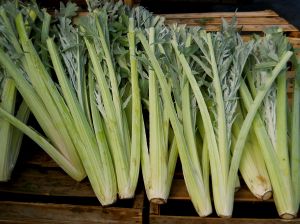Cardooncardoon also called the
artichoke thistle, cardone, cardoni, carduni, or cardi, is a thistle-like plant in the sunflower family. It is a naturally occurring species that is sometimes considered to include the globe artichoke, and has many cultivated forms. It is native to the western and central Mediterranean region, where it was domesticated in ancient times.
The wild cardoon is a stout herbaceous perennial plant growing 31 to 59 in tall, with deeply lobed and heavily spined green to grey-green tomentose (hairy or downy) leaves up to 20 in long, with yellow spines up to 3.5 cm long. The flowers are violet-purple, produced in a large, globose, massively spined capitulum up to 2 in in diameter
To prepare cardoons, first trim off the bottom and pull apart the stalks. With a
vegetable peeler, peel off any leaves and thorns, and then peel the stringy fibers off the stalks. Cut the stalks into three-inch pieces and then soak them in a bowl of water with 2 tablespoons of white vinegar for thirty minutes; the vinegar helps to reduce the bitter taste of cardoons and prevents discoloration.
Cardoons
Gratin, in which they are baked with olive oil and
cheese. Delicious and well worth making if you only plan to eat cardoons once in a great while; this recipe is Holly’s favorite.
Cardoons with the garlicky-
anchovy sauce bagna cauda. Excellent as a canape.
Cardoon
salad( also
see ), tossed in a vinaigrette. Simple and good.
Fried cardoons. Another excellent if simple dish. An unusual appetizer, especially when you coat the cardoons in
chickpea flour and fry with
olive oil.


